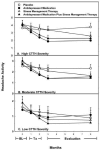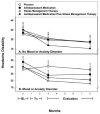Moderation and mediation in the psychological and drug treatment of chronic tension-type headache: the role of disorder severity and psychiatric comorbidity
- PMID: 19342174
- PMCID: PMC2729361
- DOI: 10.1016/j.pain.2009.02.019
Moderation and mediation in the psychological and drug treatment of chronic tension-type headache: the role of disorder severity and psychiatric comorbidity
Abstract
We evaluated two putative moderators of treatment outcome as well as the role of Headache Management Self-Efficacy (HMSE) in mediating treatment outcomes in the drug and non-drug treatment of chronic tension-type headache (CTTH). Subjects were 169 participants (M=38 yrs.; 77% female; M headache days/mo.=22) who received one of four treatments in the treatment of CTTH trial (JAMA, 2001; 285: 2208-15): tricyclic antidepressant medication, placebo, (cognitive-behavioral) stress-management therapy plus placebo, and stress-management therapy plus antidepressant medication. Severity of CTTH disorder and the presence of a psychiatric (mood or anxiety) disorder were found to moderate outcomes obtained with the three active treatments and with placebo, as well as to moderate the role of HMSE in mediating improvements. Both moderator effects appeared to reflect the differing influence of the moderator variable on each of the three active treatments, as well as the fact that the moderator variables exerted the opposite effect on placebo than on the active treatments. HMSE mediated treatment outcomes in the two stress-management conditions, but the pattern of HMSE mediation was complex, varying with the treatment condition, the outcome measure, and the moderator variable. Irrespective of the severity of the CTTH disorder HMSE fully mediated observed improvements in headache activity in the two stress-management conditions. However, for patients with a mood or anxiety disorder HMSE only partially mediated improvements in headache disability, suggesting an additional therapeutic mechanism is required to explain observed improvements in headache disability in the two stress-management conditions.
Figures




Similar articles
-
Management of chronic tension-type headache with tricyclic antidepressant medication, stress management therapy, and their combination: a randomized controlled trial.JAMA. 2001 May 2;285(17):2208-15. doi: 10.1001/jama.285.17.2208. JAMA. 2001. PMID: 11325322 Free PMC article. Clinical Trial.
-
Psychopathology and quality of life burden in chronic daily headache: influence of migraine symptoms.J Headache Pain. 2010 Jun;11(3):247-53. doi: 10.1007/s10194-010-0208-1. Epub 2010 Apr 11. J Headache Pain. 2010. PMID: 20383733 Free PMC article.
-
Update of chronic tension-type headache.Curr Pain Headache Rep. 2015 Jan;19(1):469. doi: 10.1007/s11916-014-0469-5. Curr Pain Headache Rep. 2015. PMID: 25416462 Review.
-
Accompanying symptoms and psychiatric comorbidity in migraine and tension-type headache patients.J Psychosom Res. 2006 Oct;61(4):447-51. doi: 10.1016/j.jpsychores.2006.03.005. J Psychosom Res. 2006. PMID: 17011351
-
The use of antidepressants for headache prophylaxis.CNS Neurosci Ther. 2011 Oct;17(5):462-9. doi: 10.1111/j.1755-5949.2010.00170.x. Epub 2010 Jul 7. CNS Neurosci Ther. 2011. PMID: 21951370 Free PMC article. Review.
Cited by
-
Migraine in gulf war illness and chronic fatigue syndrome: prevalence, potential mechanisms, and evaluation.Front Physiol. 2013 Jul 24;4:181. doi: 10.3389/fphys.2013.00181. eCollection 2013. Front Physiol. 2013. PMID: 23898301 Free PMC article.
-
Psychometric properties of the Danish versions of headache-specific locus of control scale and headache management self-efficacy scale.J Headache Pain. 2009 Oct;10(5):341-7. doi: 10.1007/s10194-009-0143-1. Epub 2009 Aug 19. J Headache Pain. 2009. PMID: 19690940 Free PMC article.
-
Corticotropin-releasing factor receptor 1 antagonist alters regional activation and effective connectivity in an emotional-arousal circuit during expectation of abdominal pain.J Neurosci. 2011 Aug 31;31(35):12491-500. doi: 10.1523/JNEUROSCI.1860-11.2011. J Neurosci. 2011. PMID: 21880911 Free PMC article. Clinical Trial.
-
Tricyclic antidepressants for migraine and tension-type headaches.BMJ. 2010 Oct 20;341:c5250. doi: 10.1136/bmj.c5250. BMJ. 2010. PMID: 20961989 Free PMC article.
-
Mediators and moderators of chronic pain outcomes in an online self-management program.Clin J Pain. 2015 May;31(5):404-13. doi: 10.1097/AJP.0000000000000125. Clin J Pain. 2015. PMID: 24918473 Free PMC article. Clinical Trial.
References
-
- Andrasik F, Lipchick G, McCrory D, Wittrock D. Outcome measurement in behavioral headache research: headache parameters and psychosocial outcomes. Headache. 2005;45:429–37. - PubMed
-
- Ashina A, Ashina M. Current and potential future drug therapies for tension-type headache. Curr Pain Head Rep. 2003;7:466–74. - PubMed
-
- Baskin S, Lipchik G, Smitherman T. Mood and anxiety disorders in chronic headache. Headache. 2006;46:S76–S87. - PubMed
-
- Beck AT. Cognitive approaches to stress. In: Lehrer PM, Woolfolk RL, editors. Principles and practice of stress management. New York: The Guilford Press; 1993. pp. 333–71.
-
- Bendtsen L, Mathew N. Prophylactic pharmacotherapy of tension-type headache. In: Olesen J, Goadsby P, Ramadan N, Tfelt-Hansen P, Welch K, editors. The headaches. Philadelphia: Lippincott Williams & Wilkins; 2006. pp. 735–41.
Publication types
MeSH terms
Substances
Grants and funding
LinkOut - more resources
Full Text Sources
Medical

